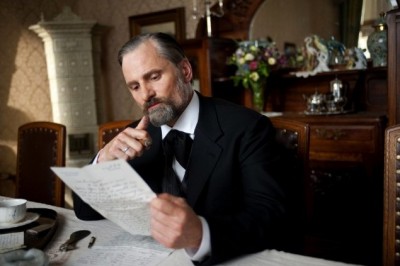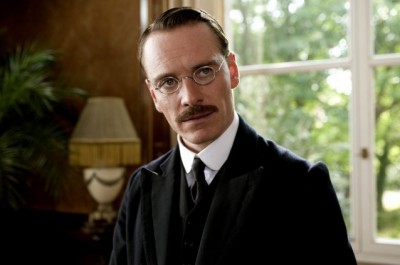“A Dangerous Method” — A Film Review by Gary Chew
Not being a student of Sigmund Freud, Carl Jung and Sabina Spielrein (not to mention Otto Gross), it’s difficult knowing to what extent accuracy has been taken in David Cronenberg’s “A Dangerous Method.” But suppose that what’s depicted in this really chatty film is what happened, starting, as it did, one century and eight years ago.

Let’s begin with a line spoken by Viggo Mortensen (as Dr. Sigmund Freud). With the soaring phrase of the sentence being “…the black mud of superstition,” it’s easy to infer that Cronenberg continues his intellectual-like and rather kinky cinematic surveys. With “Method” there’s guilt, doctor/patient and teacher/student relationships, as well as what drives human sexuality and any connection it might have to death…all with occasional strains of Wagner quietly sounding in the background. Cronenberg and Lar von Trier (“Melancholia”) were big on Wagner in 2011. Surely somewhere in one of these movies, there’s a Siegfried.
As I watched “A Dangerous Method,” I expected Friedrich Nietzsche to suddenly appear any second. But he didn’t, which says something about the historical accuracy of the film. Nietzsche died a hundred-twelve years ago.
“Method” is a curiously constructed triangle of real persons in a story that has only two of them involved sexually, but all three intellectually engaged. The intellectual part has to do with what makes human brains tick which, in turn, signals emotions and, thus, actions taken…due to the kind of ticking going on. In this case, in the brain of Sabina Spielrein (Keira Knightly). Actually, Spielrein was Russian-born, and became one of the first female psychiatrists.
Sabina, “almost in a basket” you might say, is institutionalized and comes under the “talking cure” of Dr. Carl Jung (Michael Fassbender). Jung’s wealthy, lovely and mild-mannered, yet intuitive wife, Emma (Sarah Gadon) is with child. After some overacted scenes by Ms. Knightly in varying states of hysteria, which seem to be a product of Sabina’s earlier life, caused by a really jerk of an authoritarian father, she and Jung succumb to sex play (definitely a doctor/patient no-no).
The couple then swears-off the liaison (Jungian guilt?), for a while, and Carl becomes Sabina’s unofficial graduate adviser as she finalizes her doctoral dissertation (definitely teacher/student no-no). The subject of her dissertation brings the principles closer together.
Thickening the psychological brew a bit is a real psychoanalytic pagan of a fellow called Otto Gross (Vincent Cassel). It’s decadence in full-swing as Gross, in therapy with Jung, nearly persuades his somewhat religious psychiatrist to a rather anarchistic attitude of life and sex. Does it just happen, at about that time, Carl and Sabina become intimate? Maybe a question on her final quiz should’ve been “Who’s treating whom? It comes out that, like Sabina, Otto also has a very strict father.

Freud’s character is held at somewhat of a distance although it plays an important part in the script. I’ve never seen Mortensen better in a role. And Fassbender, doing Jung, is smooth as glass. Cassel, you’d swear, is Otto Gross, particularly if you ever happen to look up information on the historical Mr. Gross. Although hardly as well-known as Freud, Gross was on a Freudian path maybe a bit before Sigmund, but apparently he wasn’t nearly as well-organized and responsible as the Father of Psychoanalysis.
“Method” is much with conversation and little on action, but the historical import of the the film and its personalities, as they relate to the beginning of the 20th century and what’s soon to follow (WWI), provide most of its fuel. Closing the eyes occasionally won’t cause you to miss a lot of this movie, even though there’s a lot to get.
For instance: Sabina, a Jew like Freud, finally marries a Jewish man and has two children. They return to Russia. Not much later, Sabina’s spouse perishes under the heel of Stalin and she and her children are executed by a rifle squad of German SS officers. Freud flees Nazi-occupied Austria to London where he dies of cancer in 1939. Jung outlives them all, but not before suffering two nervous breakdowns.
The arguments among these heady pioneers who seemed overwhelmed by their own curiosity about human behavior bring to mind another heavyweight of that day: Albert Einstein. What any of the notables in “A Dangerous Method” said and wrote regarding their inchoate positions on psychoanalysis meet a formidable challenge with Einstein’s famous quote that “…reality is merely an illusion, albeit a persistent one.”
A play titled “The Talking Cure” was used by its playwright for the “Dangerous Method” adaptation. He also did the screenplay for the excellent film, “Atonement.” Christopher Hampton is his name. Both his play and movie script about Freud, Jung and Spielrein rattle about, ironically, in what might be called the “psycho-circumstance” of today. All the debate of how the mentally disturbed are best treated, particularly as Freudian Psychology was coming into vogue, seems to pale and fall moot, since fewer contemporary patients receive “the talking cure”—unless they can afford it.
It’s more often that a cathartic shrink one-on-one is supplanted by a plastic bottle of capsules or tablets prescribed by a psychiatrist in an office somewhere.
Don’t forget to sign-off on the Seroquel, Sigmund.

Now playing at the Tower Theatre in Sacramento.
- Movie Review: ‘The Glorias’ - September 28, 2020
- Movie Review: ‘I’m Thinking of Ending Things’ - September 10, 2020
- Movie Review: ‘The Burnt Orange Heresy’ - August 31, 2020


